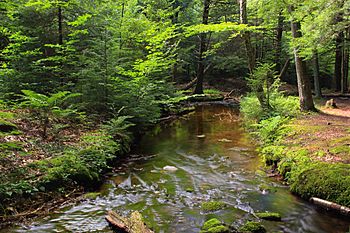Painter Creek facts for kids
Quick facts for kids Painter Creek |
|
|---|---|

Painter Creek looking downstream near its headwaters
|
|
| Physical characteristics | |
| Main source | northeast of Big Pine Hill in Thornhurst Township, Lackawanna County, Pennsylvania between 2,000 and 2,020 feet (610 and 620 m) |
| River mouth | Panther Creek in Spring Brook Township, Lackawanna County, Pennsylvania 1,411 ft (430 m) 41°16′59″N 75°37′51″W / 41.2830°N 75.6307°W |
| Length | 3.4 mi (5.5 km) |
| Basin features | |
| Progression | Panther Creek → Spring Brook → Lackawanna River → Susquehanna River → Chesapeake Bay |
| Basin size | 4.51 sq mi (11.7 km2) |
| Tributaries |
|
Painter Creek is a small stream located in Lackawanna County, Pennsylvania. It flows into Panther Creek. The creek is about 3.4 miles (5.5 km) long. It runs through Thornhurst Township and Spring Brook Township. The area that drains water into Painter Creek is about 4.51 square miles (11.7 km2).
Cool fact: wild trout naturally live and have babies in this creek! There is also a hiking trail nearby. The ground around the creek has special soil from glaciers, rocks, and wet areas. A unique wet area called Painter Creek Bog is also found here.
Contents
The Creek's Journey: Where Does Painter Creek Flow?
Painter Creek starts in Thornhurst Township. Its source is northeast of a place called Big Pine Hill. The creek first flows west, then turns north through a valley. After about a mile, it heads north into Spring Brook Township.
It then flows north-east for over a mile. Along the way, two smaller streams join it from the left side. Finally, Painter Creek meets and joins Panther Creek. Painter Creek joins Panther Creek about 0.90 square miles (2.3 km2) before Panther Creek ends.
Land and Rocks: What's Under Painter Creek?
The land around Painter Creek is interesting. The elevation near where Painter Creek joins Panther Creek is about 1,411 feet (430 meters) above sea level. Near where the creek starts, the elevation is much higher. It is between 2,000 and 2,020 feet (610 and 616 meters) above sea level.
The ground around Painter Creek is mostly made of a special type of soil. This soil is called Wisconsinan Till. It was left behind by glaciers long ago. Farther from the creek, you can find solid bedrock. This bedrock is made of different kinds of rocks. These include conglomerate, shale, and sandstone. There are also a few wetland areas, which are like marshy spots.
The Creek's Home: Understanding the Watershed
The watershed of Painter Creek covers about 4.51 square miles (11.7 km2). A watershed is the area of land where all the water drains into one main stream or river. Most of this watershed is in Thornhurst Township and Spring Brook Township. However, a small part of it is in Bear Creek Township in Luzerne County.
The mouth of the creek is shown on the United States Geological Survey map called Avoca. But the source of the creek is on the map called Pleasant View Summit.
Painter Creek Bog: A Special Wet Area
A unique bog called the Painter Creek Bog is found in this watershed. It is listed on the Lackawanna Natural Areas Inventory. This bog is a kettlehole bog. This means it formed in a hollow left by a melting block of glacial ice. It is in good condition and has not been disturbed much by people.
The bog is located in Pinchot State Forest. It covers about 5 acres (2.0 ha). About 0.5 acres (0.20 ha) of the bog is open water. The main threats to this special area are flooding caused by beavers and logging.
History and Fun: Exploring Painter Creek
Painter Creek was officially named and added to a national information system on August 2, 1979. In the early 2000s, experts suggested that Spring Brook Township should protect Painter Creek. They wanted the township to include this protection in their plans for land use.
In 2012, the Pennsylvania Fish and Boat Commission thought about adding Painter Creek to its list of wild trout streams. This means it's a great place for trout to live naturally.
The Painter Creek Greenway was also suggested. A greenway is a natural area that can be used for recreation. The entire length of Painter Creek is located within Pinchot State Forest. The Pinchot Trail, a long hiking trail that is 23 miles (37 kilometers) long, passes very close to the creek in one section.
Wildlife and Plants: What Lives in and Around Painter Creek?
Wild trout naturally live and reproduce in Painter Creek. They can be found from where the creek starts all the way to where it ends. In the late 1800s, bears were seen near Painter Creek.
The Painter Creek Bog is home to special plants. It mainly has a floating peat mat. This mat is made of low-growing sphagnum moss and grass-like plants. You can also find shrubs like highbush blueberry in the bog. Farther away from the bog, there are boreal conifer trees. These include spruce and larch trees.
Images for kids


